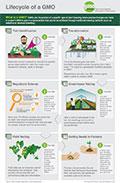Question
Every system from the dawn of civilization has its pros and cons. Even organic farming scientists will admit to theirs. What would the GMO Agriculture scientists say were the CONS of GMO seeds and chemical farming? We have only heard the pros and the fear tactics that farmers and our economy would be ruined if we label GMOs, for example. Is it just that many Americans have our suspicions based on this? Can you answer this question clearly?
Submitted by: Stu Smith
Answer
Expert response from Community Manager
Wednesday, 11/02/2015 20:12
Agriculture is a human endeavor and does have impacts on the environment. It has for many thousands of years. We are constantly striving to develop new ways to improve production methods and reduce agricultural inputs while meeting the demands of a growing world population. Genetically engineered crops are certainly not a “silver bullet” but they are certainly an important tool in the food production toolbox. And the benefits far outweigh the costs.
With respect to your phrase “chemical farming,” I am going to assume that you are referring to farming practices that incorporate synthetic chemicals as part of the production practice (insecticides, herbicides, fertilizers, plant growth regulators, etc). One of many things that distinguishes conventional or GE crop farming from organic farming is the option to use synthetic chemicals. It is important to note that while organic production is prohibited from using many synthetic products, organic farming does incorporate chemistry into its production practices. For instance, synthetic chemical fertilizers are not allowed but organic fertilizers such as manure are allowed. All farmers, no matter how they produce their crops, have to control weeds and pests (see this link for approved chemistries in organic production).
It is important to note that when we are discussing GE crops in the United States, we are really only talking about three primary crops (corn, soybeans, cotton) and two traits (insect tolerance and herbicide tolerance). There are exceptions of course (e.g. herbicide tolerant alfalfa, herbicide tolerant sugar beets, and drought-tolerant corn), but these represent relatively low acreage crops compared to other crops such as corn, soybeans, and cotton. Please note that there is no GM wheat on the market, and virtually no GM vegetables (squash and sweet corn are exceptions).
Currently, more than 90% of corn, cotton and soybeans grown in the US are genetically engineered. Adoption of these GE crops is high as farmers extract value through better weed control and pest management options, better returns, and the benefits of more environmentally beneficial production options. So, while the benefits of GE crops at the farm-level are numerous (which explains the high rate of adoption of the technologies), there is a huge gap between these benefits and what the end consumer perceives as value-added for consumption. This gap- which can be called a CON- leads to misunderstandings and misinterpretations of the science and the technology and, as a result, questions around ‘safety’ of GE crops.
So, how safe are these genetically engineered crops? What does this mean for us as consumers? All food sold in the US must meet strict FDA requirements for safety, however only GE crops must undergo an extensive evaluation and approval process before being placed on the market - this is both a PRO (safety assurance) and CON (delays getting products to market, and very costly). There are even some examples where genetically engineered crops may be safer than conventional or organically grown counterparts. Take, for example, Bt corn. While the technology was developed to control a high percentage of the caterpillars that feed on it, it can also reduce the level of fungal contamination (that produces human carcinogenic compounds) on that same ear of corn.
Another drawback of genetically engineered crops is that their use is prohibited under USDA’s certified organic program. Thus, if a farmer wants to produce organic crops to meet a particular market, they cannot use genetically engineered crops. This limits organic producers’ options. They miss out on some beneficial traits that could potentially increase productivity levels and provide the organic market with good, environmentally friendly food production options.
Another CON of GMO’s is the time and money it takes to bring a genetically engineered crop to the market. Currently it costs $130-$150 million dollars and more than 10 years. When time and resources are entangled in a complex regulatory process, industry is restricted in terms of the type and number of traits that can be developed, and what beneficial technologies (pest and disease resistance, water or nutrient efficiencies, nutritional composition) that they can target that will bring value to farmers and/or consumers. These regulatory costs may also prevent small and medium enterprises from producing GE crops and essentially is why large corporations have developed most of the products found on the market today. These costs are also one of the reasons why GE crops currently on the market in the US are primarily major row crops.
For additional reading, Robert Wager covers the issues associated with genetically engineered crops in more detail here in another response on GMOAnswers. These issues included costs, germline biodiversity, cross-pollination, fertilizer use and herbicide resistant weeds.
GMO Innovation Contest Recap!
